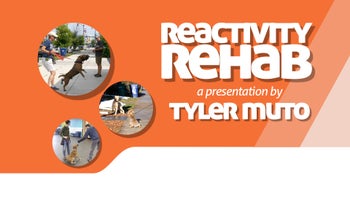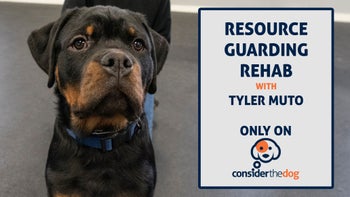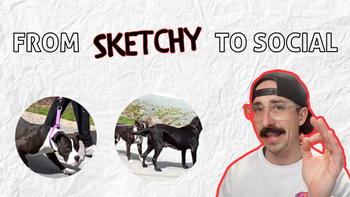The Best Online Courses For Dog Aggression
Dog aggression can feel overwhelming, scary, and isolating — but with the right guidance, the situation becomes manageable, hopeful, and even inspiring. Today, thousands of dog owners are turning to the best online dog aggression courses to solve everything from reactivity to resource guarding. Online training doesn’t just offer flexibility — it delivers step-by-step solutions from world-class trainers, right from your living room.
Below, we break down the most effective online aggression courses, including programs from Evan Doggett, Tyler Muto, and Brett Bailey, and explain how each course can transform your dog’s behavior. The best part is that all of these courses are included in the low price membership options at Consider The Dog! These are only a few of the online courses available in the Consider The Dog membership that can help you train your aggressive dog.
Understanding Dog Aggression in the Modern World
Dog aggression is more common than most people think. Modern life is busy, stimulating, fast-paced — and dog behavior issues often slip through the cracks until they escalate. Aggression can appear suddenly, or it can build slowly over time.
But here’s the encouraging truth:
👉 Aggression is almost always a symptom, not a personality trait.
Common Types of Dog Aggression
Dogs may show aggression for different reasons, such as:
Fear-based aggression
Territorial behavior
Resource guarding
Leash reactivity
In-home conflict between dogs
Genetic tendencies combined with poor early socialization
Identifying the root cause helps determine the right training approach.
Why Online Learning Works for Aggressive or Reactive Dogs
Many owners are surprised by how effective virtual training is. In fact, online courses often outperform in-person training because:
Aggressive dogs learn better in a calm, familiar environment
Owners can rewatch lessons anytime
No travel = lower stress
Step-by-step video demos improve clarity
Trainers can show full case studies, not limited in-person sessions
The best online dog aggression courses combine science-backed methods, balanced training tools, and real-life case studies with real, challenging dogs.
What to Look for in the Best Online Dog Aggression Courses
Choosing the right course matters. Here’s what separates outstanding programs from average ones.
Trainer Credentials & Balanced Methodology
Great aggression trainers understand canine psychology deeply and use:
Relationship-based training
Clear communication
Food rewards
E-collar or prong collar conditioning (when appropriate)
Desensitization & counter-conditioning
Confidence-building exercises
Balanced methods work because they acknowledge how dogs actually learn best.
Structure, Clarity & Support Features
A great course should offer:
Step-by-step explanations
Video examples of real dogs
Homework structured for progress
Clear troubleshooting
Access to updates or community support
Courses in this article check all these boxes.
Top Recommended Programs: The Best Online Dog Aggression Courses Reviewed
Below are the standout programs every dog owner should consider.
In Home Fighting by Evan Doggett
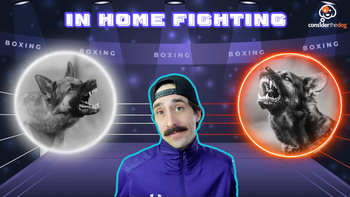
This powerful course follows two German Shepherds who started as housemates but turned into bitter enemies. Evan walks you through the entire journey — from the first consultation to the moment the dogs finally relax around each other again.
Inside the Case Study of Two Aggressive German Shepherds
Evan breaks down:
How to ask the right diagnostic questions
How to gather client feedback
Nutrition factors that affect behavior
Balancing food training and e-collar communication
How to design a customized behavior plan
How balanced methods create peace between battling dogs
This course is ideal for multi-dog households, especially those dealing with in-home aggression or rivalry.
Socialization for Difficult Dogs by Tyler Muto

Early socialization can determine the entire future of an insecure or reactive dog. In this course, Tyler and trainer Lexi work with three different dogs, each presenting unique challenges.
Early Social Foundations That Change Everything
You will learn:
How to assess new dogs safely
The correct way to introduce reactive or fearful dogs
Universal principles of socialization
How to set up successful group interactions
How to avoid common mistakes that increase aggression
This program is especially helpful for owners of insecure, nervous, or potentially dangerous dogs.
Anger Management by Brett Bailey
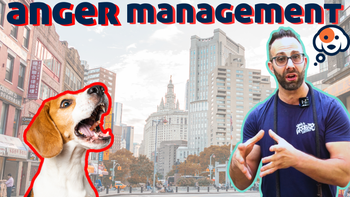
This course focuses on the fundamentals needed to transform a reactive dog into a confident, relaxed companion.
Building a Calm, Confident, and Happy Dog
Inside the program, you’ll discover:
How triggers develop into reactivity
Confidence-building drills
Leash communication skills
Pattern training for calmer walks
How to reset your dog’s emotional baseline
Brett’s compassionate, easy-to-follow style makes this course extremely beginner-friendly.
Reactivity Rehab by Tyler Muto
If you want fast progress without hours of daily training, this course is a game changer.
A Faster, Smarter Approach to Reactive Dogs
You’ll learn:
A unique framework for understanding reactivity
Why efficiency matters in modern families
A simple, step-based method that saves time
Real case studies with reactive dogs
Core skills for building impulse control
Tyler’s approach is ideal for busy owners who want maximum progress with minimal confusion.
Resource Guarding Rehab by Tyler Muto
Resource guarding can become dangerous quickly — but this course breaks the process into small, achievable steps.
The Building-Block System for Long-Term Success
Inside, Tyler teaches:
Counter-conditioning foundation work
Remote collar communication
How to remove conflict from training
How to rebuild trust
A step-by-step system using “building blocks”
This course works for both everyday dog owners and professional trainers wanting advanced techniques.
From Sketchy to Social by Evan Doggett
This heartwarming video series follows Nola, a reactive rescue Pitbull, through her journey from fearful to friendly.
Nola’s Transformation From Fearful to Friendly
You’ll learn:
How to address antisocial behavior
Balanced training with food + e-collar
How to create emotional change, not just obedience
How to socialize safely
How to build a dog’s confidence with structure
Nola’s story alone makes this one of the best online dog aggression courses available.
How to Choose the Right Course for YOUR Dog
Every dog is different — and choosing the right program depends on your dog’s personality, history, and triggers.
1. Consider What Type of Aggression You're Dealing With
Match the issue to the course:
Dog vs. dog in the home → In Home Fighting
Fearful or socially anxious dog → Socialization for Difficult Dogs
General reactivity or over-arousal → Anger Management
Leash reactivity with busy owners → Reactivity Rehab
Stealing, protecting, guarding items → Resource Guarding Rehab
Rescue dog with a rough past → From Sketchy to Social
2. Consider Your Dog’s Learning Style
Food-motivated?
Noise-sensitive?
Socially driven?
Stubborn or anxious?
Courses like Evan Doggett’s rely strongly on food + tool communication, while Tyler Muto’s programs are systems-based and methodical.
3. Consider Your Own Schedule
If you’re busy, Reactivity Rehab may be the perfect fit.
If you prefer deep case studies, In Home Fighting offers that.
4. Match the Course to Your Confidence Level
Beginners often love:
More experienced handlers may prefer:
Realistic Expectations: What Online Aggression Training Can and Can’t Do
Online courses can be life-changing, but it’s important to stay grounded.
✔ What Online Courses CAN Do
Provide proven, repeatable methods
Build your confidence as a handler
Transform mild to moderate aggression
Fix leash reactivity
Improve socialization
Create calm, predictable behavior
Offer lifelong access for review
❌ What Online Courses CAN’T Do
Replace emergency intervention for dangerous bite histories
Fix problems if instructions aren’t followed
Guarantee overnight transformation
If your dog has caused severe injuries, an in-person professional is necessary.
FAQs About the Best Online Dog Aggression Courses
1. Are online aggression courses as effective as in-person training?
Yes — for many dogs, online courses actually work better because they remove stressful environments, allow unlimited rewatching, and give owners step-by-step clarity.
2. How long does it take to see results?
Most owners see small improvements within one week, with major changes occurring in 4–8 weeks, depending on the program and follow-through.
3. Can online courses help with severe aggression?
They can help, but cases involving repeated bites, emergency-level aggression, or unpredictable behavior should include an in-person professional as well.
4. Which course is best for leash-reactive dogs?
Both Anger Management and Reactivity Rehab are excellent for leash issues.
Choose Reactivity Rehab if you want the fastest structured plan.
6. Can multiple people in the household follow the same course?
Absolutely — online courses are perfect for families. Everyone can watch the same videos, ensuring consistent communication with the dog.
Final Thoughts on Finding the Best Online Dog Aggression Courses
Aggression can feel scary, but it’s often just a sign your dog needs clearer communication, better structure, and emotional support. The best online dog aggression courses offer exactly that — professional guidance, real-world demos, and a path to lasting change.
Whether you choose Evan Doggett, Tyler Muto, or Brett Bailey, each program brings powerful tools to help your dog feel safer, calmer, and more confident.
You’re not alone on this journey — and with the right course, your dog’s story can become a transformation worth celebrating.

